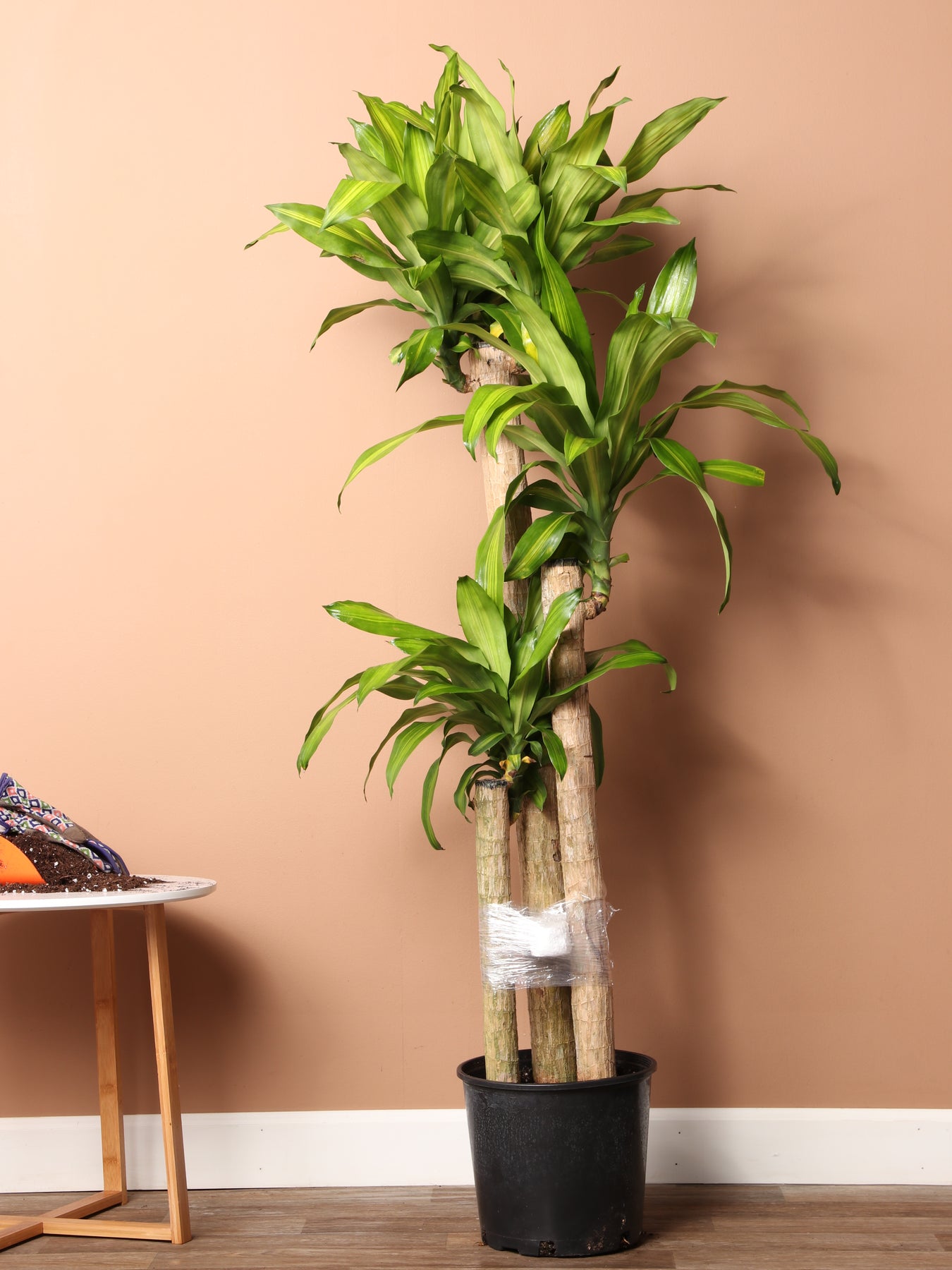Mass cane (Dracaena fragrans ‘Massangeana’ or Dracaena fragrans), popularly known as the Mass Cane Plant or “corn plant,” is one of numerous prominent Dracaena cultivars, which include Dracaena lisa, Dracaena marginata, and Dracaena compact.
Mass Cane Plant: A Low-Maintenance Beauty
Appearance
It has stalky stems and long green leaves with light-yellow/light-green stripes down the center. It is an easy-to-grow houseplant that takes minimal care (and may even tolerate neglect), making it an excellent choice for novices.
Where It Grows
Although the mass cane originated in Africa, it is now popular in many homes and businesses in the United States and the United Kingdom due to its low-maintenance nature.
The following are maintenance guidelines for dedicated gardeners who want to grow mass cane under perfect conditions.
Fast Facts about Mass Cane
- Height: 4–6 feet tall
- Ideal Temperature: 60°F (15°C) to 75°F (24°C).
- Light: Indirect bright is ideal, no direct sunshine; can withstand low light.
- Water once a week and use any well-drained soil.
Is the Mass Cane Plant Toxic for Dogs?
If dogs and cats eat mass cane, they will die. If you feel your pet has consumed any part of a mass Cane plant and is exhibiting symptoms, you should call your veterinarian for guidance.
Note: While this plant is not poisonous to humans, consuming any part of it is not suggested.
Mass Cane Plant Care
As previously said, mass cane is a low-maintenance plant that adds luxuriant appeal to indoor settings. Here’s all you need to know to keep your “corn plant” healthy.
What Temperatures Can Dracaena Tolerate?
The optimal temperature range for bulk cane is 60°F (15°C) to 75°F (24°C). The leaf edges will turn light gray or brown at temperatures below 55°F/12°C. Protect it from the wind and cold by keeping it away from open windows in the winter.
In the summer, move the plant away from any windows that receive direct sunlight, or use a curtain to block the heat. If you see that the leaves begin turning towards the inside of your house or curling, it is an indication that the plant is attempting to protect itself against sunburn.
Light Requirements
Mass cane can handle a variety of indoor lighting situations, but it flourishes best in areas with bright, indirect sunshine. This plant requires only moderately bright light to develop and produce healthy-looking leaves. It works best on a porch or near an east-facing window.
The plant will grow quicker under bright light, but the leaves may bleach or burn, and the soil will dry up too rapidly. To avoid chlorosis symptoms, fertilize on a regular basis and use a curtain to deflect sunlight.
Mass cane is very tolerant of low light circumstances, although it grows significantly slower and its leaves may turn yellow or brown. If you’re growing in low light, water less regularly to avoid root rot and browning leaves.
Ideal Humidity Level
Because mass cane is a tropical plant, it thrives under heavy humidity. It works well under regular humidity, though. If the leaves begin to brown and you suspect low humidity, spray the foliage daily to keep them moist. Mass cane also benefits from having other plants around to help create humidity.
How Often Should You Water A Mass Cane?
Watering is rather straightforward. If placed in moderate light, water the plant when the soil surface feels dry to the touch. Water the mass cane just enough to wet the soil in the entire pot. In most moderate settings, there is no reason to leave surplus water in the plant’s liner. Allow the soil’s surface to dry to the touch before watering again.
In moderate light, water the plant once or twice a week.
In places with high light levels, it may be required to leave some water in the liner or add water more often.
In low light, you should water less regularly. Allow canes in low light to dry.
Remember that bulk cane is a plant that grows and reacts slowly. It may take weeks for the plant to show signs of overwatering or underwatering; by then, the damage has already done.
What’s the Best Soil to Use?
Mass cane is not choosy, therefore any well-drained soil will suffice. I recommend using a multipurpose or indoor potting mix. Peat moss-based potting soil will also enhance drainage. Make sure the pot has a draining hole, as standing water will cause root rot in bulk canes.
Why is my Mass Cane Plant Turning Brown?
When your bulk cane’s leaves become brown or yellow, it could mean one of the following:
Overwatering or underwatering causes the leaves to yellow at the margins before spreading to the center.
Cold Temperature: Keep your bulk cane away from drafty regions and place it in a warm position with plenty of indirect sunshine.
Fluoride Toxicity: Stop fertilizing your plants immediately. Fertilizers include more fluoride than the bulk cane prefers or can tolerate. If you suspect a fluoride overdose, replace tap water with bottled water or rainwater.
Other Common Problems
Although this plant is simple to care for, it does have some common concerns.
What Is Wrong with My Mass Cane Plant?
Mealy bugs are the most prevalent pest. The best treatment is to keep your plant healthy, remove any apparent pests from its leaves, and remove new leaf crowns as needed.
Brown patches on the leaves, particularly new growth, are prevalent. There are several plausible explanations for this. An older plant may have roots that have grown outside the pot and need to be trimmed away. Additionally, salts from the water can accumulate in the soil, necessitating the addition of extra soil. If new growth has spots, trim the crowns to promote fresh, healthier growth.
Older plants may have overgrown stalks, which can become spindly and out of control. The stalks should be trimmed back.
Tilted, leaning, or crooked canes are typically caused by a plant tilting toward or away from a light source, as well as unequal watering. It could also be caused by a plant being toppled over or violently moved. To straighten a cane, just put it back into an upright posture and pack dirt as backfill for stability. Also, rotate your plant on a regular basis to keep it balanced, and water evenly throughout the soil’s surface.
Wrinkled stalks are the result of heavy underwatering or root damage.
Rotten stalks, also known as mushy canes, are caused by excessive watering and root damage.
Fungus gnats can be problematic for any indoor plant. They are most usually caused by excessive irrigation.
What if one stalk is healthy while another exhibits symptoms?
Mass canes typically feature several stalks. Canes in pots with diameters of 10″ or greater have a tapering height above and below the soil level. The tallest stalk’s roots will be deepest in the pot, while the shortest will be closest to the soil surface. Keeping these depth discrepancies in mind can aid in troubleshooting any watering problems.








